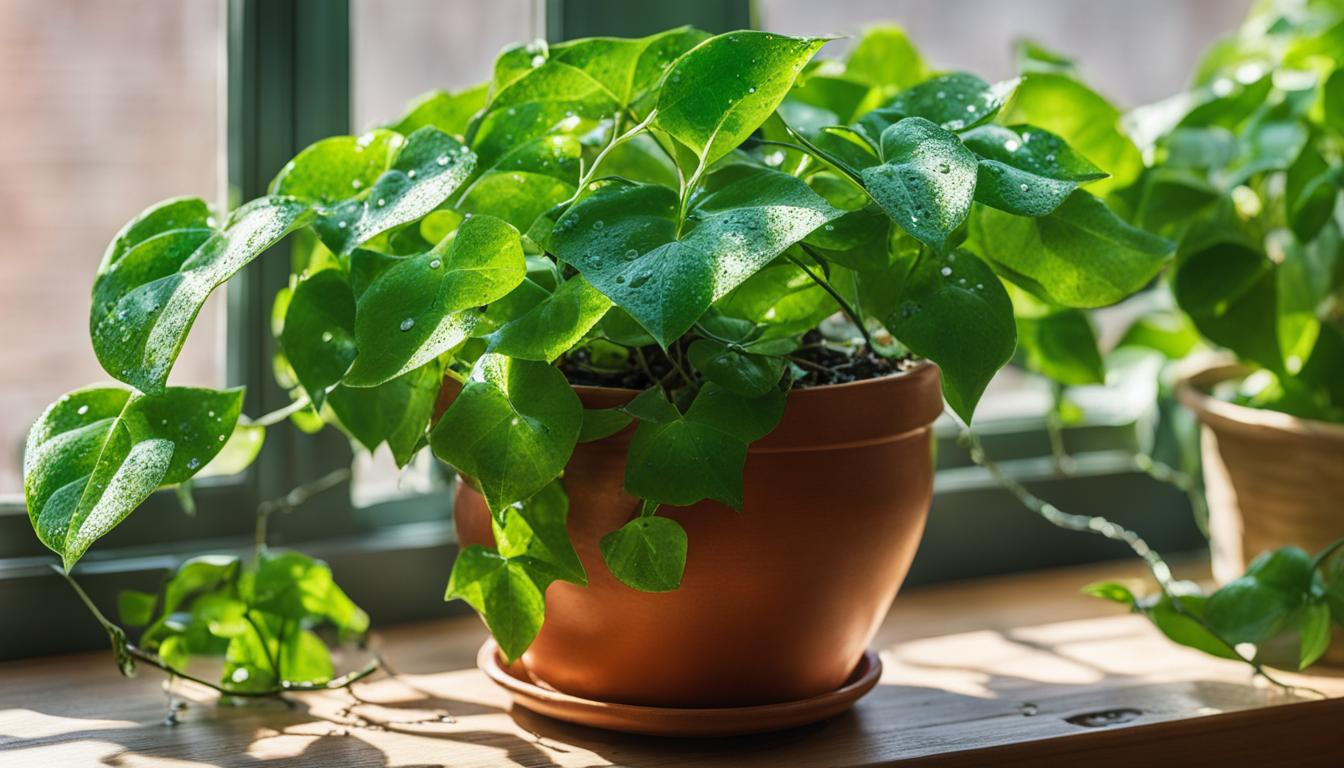Welcome to our comprehensive Sugar Vine Plant Care Guide! If you’re a plant enthusiast looking to add a touch of elegance to your indoor garden, the Sugar Vine Plant, scientifically known as Cissus Alata, is a perfect choice. In this guide, we will provide you with essential care tips and tricks to ensure that your sugar vine plant thrives and brings beauty to your space. From watering tips to providing the right light and nutrient needs, we’ve got you covered. Let’s dive in!
When it comes to caring for your sugar vine plant, there are a few key considerations to keep in mind. By following these sugar vine care tips, you can ensure that your plant stays healthy and vibrant. Whether you’re a beginner or an experienced plant parent, this guide will provide you with the knowledge and guidance you need to care for your sugar vine plant effectively.
In the following sections, we will cover important topics such as watering tips, providing the right light, nutrient needs, and even how to propagate your sugar vine plants. By the end of this guide, you’ll have all the tools to create an optimal environment for your sugar vine plant to thrive.
So, let’s get started with the first section: Watering Tips for Sugar Vine Plants. Stay tuned for valuable insights on how to keep your plants happy and healthy!
Watering Tips for Sugar Vine Plants
Proper watering is essential for maintaining the health and vitality of your sugar vine plants. These plants have specific watering requirements that should be followed to ensure optimal growth. Here are some essential watering tips to keep your sugar vine plants happy and thriving:
- Watering Frequency: Sugar vine plants prefer a slightly moist soil environment. Water your plants when the top inch of soil feels dry to the touch. Avoid overwatering, as this can lead to root rot and other moisture-related issues.
- Watering Technique: When watering your sugar vine plants, aim to moisten the soil evenly. Avoid pouring excessive water directly onto the leaves or stems, as this can promote fungal diseases. Instead, water at the base of the plant, allowing the water to soak in gradually.
- Drainage: Sugar vine plants require well-draining soil to prevent waterlogged roots. Ensure that your plant’s pot or container has drainage holes to allow excess water to escape. This will help prevent water from pooling in the container and causing root rot.
By following these watering tips, you can provide the right amount of moisture for your sugar vine plants, promoting healthy growth and preventing water-related issues.
Table: Watering Frequency Guide for Sugar Vine Plants
| Plant Size | Watering Frequency |
|---|---|
| Small Sugar Vine Plant | Water once every 7-10 days |
| Medium Sugar Vine Plant | Water once every 5-7 days |
| Large Sugar Vine Plant | Water once every 3-5 days |
It’s important to note that these watering frequencies are general guidelines and may vary depending on factors such as temperature, humidity, and the specific needs of your sugar vine plant. Always monitor the moisture level of the soil and adjust your watering routine accordingly.
Providing the Right Light for Sugar Vine Plants
Sugar vine plants, also known as Cissus Alata, thrive when provided with the right amount of light. While they can tolerate low light conditions, they prefer bright, indirect light. Here are some tips to help you provide the optimal lighting conditions for your sugar vine plant:
1. Find the Ideal Location
Place your sugar vine plant in a location where it can receive bright, indirect light. Avoid placing it in direct sunlight, as this can scorch the leaves. East or west-facing windows are usually a good choice, as they provide gentle morning or afternoon light.
2. Rotate the Plant
To ensure even growth and prevent your sugar vine plant from leaning towards the light source, rotate it every few weeks. This will help all parts of the plant receive an equal amount of light, promoting balanced growth.
3. Supplement with Artificial Light
If your sugar vine plant is not receiving enough natural light, you can supplement it with artificial light. Use fluorescent lights or specialized grow lights designed for indoor plants. Position the light source a few inches above the plant to mimic natural sunlight.
By following these tips, you can provide the right light for your sugar vine plant and keep it healthy and happy.

Table: Different Lighting Conditions for Sugar Vine Plants
| Lighting Condition | Effects on Sugar Vine Plants |
|---|---|
| Bright, indirect light | Ideal for healthy growth and vibrant foliage |
| Low light | Tolerated, but may result in slower growth and less abundant foliage |
| Direct sunlight | Can scorch the leaves and cause damage |
| Artificial light | Can supplement natural light and promote growth indoors |
Nutrient Needs of Sugar Vine Plants
Sugar vine plants have specific nutrient needs to support their growth and overall health. By providing the right nutrients, you can ensure that your sugar vine plant thrives and remains vibrant. Here are some essential tips for maintaining the nutrient levels of your sugar vine plant:
Essential Nutrients for Sugar Vine Plants
Like all plants, sugar vine plants require a balanced mix of essential nutrients to flourish. These include:
- Nitrogen (N): This nutrient is essential for promoting healthy leaf and stem growth in sugar vine plants.
- Phosphorus (P): Phosphorus aids in root development and overall plant vigor.
- Potassium (K): Potassium is crucial for flower and fruit production in sugar vine plants.
- Calcium (Ca): Calcium helps maintain the structure and health of the plant’s cell walls.
- Magnesium (Mg): Magnesium is a key component in chlorophyll production, which is essential for photosynthesis.
While these are the primary nutrients required by sugar vine plants, they also benefit from other micronutrients such as iron, zinc, and manganese.
Providing Nutrients to Your Sugar Vine Plant
One way to provide nutrients to your sugar vine plant is through regular fertilization. Choose a balanced fertilizer specifically formulated for indoor plants or houseplants. Follow the specific instructions on the fertilizer packaging to ensure you are applying the correct amount. Over-fertilization can damage the plant, so it’s important to follow the recommended dosage.
Another way to supply nutrients is through organic matter. Adding compost or well-rotted manure to the soil can enrich it with essential nutrients over time. This natural approach helps improve soil structure and fertility, benefiting the overall health of your sugar vine plant.
Regularly monitor your plant for any signs of nutrient deficiencies, such as yellowing leaves or stunted growth. Adjust your fertilization routine or consult a plant expert if you notice any issues.
Summary:
Ensuring that your sugar vine plant receives the right nutrients is essential for its overall growth and well-being. Remember to provide a balanced mix of essential nutrients, such as nitrogen, phosphorus, potassium, calcium, and magnesium. Regularly fertilize your plant using a balanced indoor plant fertilizer, or enrich the soil with organic matter like compost. Monitor your plant for any signs of nutrient deficiencies and make adjustments as needed. By following these nutrient care tips, you can maintain a healthy and thriving sugar vine plant.
Propagating Sugar Vine Plants
Propagating sugar vine plants is an exciting way to expand your collection and share the beauty of these plants with others. By following a few simple steps, you can successfully propagate your Cissus Alata and enjoy the satisfaction of growing new plants.
One popular method of propagating sugar vine plants is through stem cuttings. Start by selecting a healthy stem with several nodes, which are the points where leaves are attached. Use a clean, sharp knife or gardening shears to make a clean cut just below a node. Remove any leaves from the bottom part of the cutting to prevent them from rotting when placed in the propagation medium.
Once you have your stem cutting, you can either dip the cut end in rooting hormone or skip this step. While rooting hormone can help speed up the rooting process, it is not essential. Next, place the cutting in a well-draining propagation medium, such as a mix of perlite and peat moss. Keep the medium slightly moist and provide indirect light for the cutting to encourage root development.
Within a few weeks, you should start to see roots forming on your sugar vine cutting. Once the roots are well-established, you can carefully transplant the new plant into a pot with well-draining soil. Keep the soil slightly moist and provide the same care as you would for a mature sugar vine plant. With time and proper care, your propagated sugar vine plants will grow into gorgeous additions to your indoor garden.

Propagation Tips:
- Choose a healthy stem with several nodes for your cutting.
- Consider using rooting hormone to help speed up the rooting process.
- Use a well-draining propagation medium, such as perlite and peat moss.
- Provide indirect light and slightly moist conditions for the cutting.
- Transplant the new plant into a pot with well-draining soil once roots are established.
By following these simple steps and tips, you can successfully propagate sugar vine plants and enjoy the beauty of these unique vines throughout your home. Whether you’re looking to expand your collection or share the joy of growing plants with others, propagation is a rewarding and fulfilling experience.
| Propagation Method | Difficulty Level | Success Rate |
|---|---|---|
| Stem Cuttings | Easy | High |
| Leaf Cuttings | Moderate | Moderate |
| Air Layering | Advanced | High |
Conclusion
In conclusion, caring for your sugar vine plant is essential to ensure its health and longevity. By following these sugar vine plant care instructions, you can provide the best environment for your plant to thrive.
Remember to water your sugar vine plant appropriately, making sure not to overwater or underwater. Provide the right amount of light by placing your plant in a bright spot, but away from direct sunlight. Additionally, replenishing nutrients when needed will help support your plant’s growth and well-being.
Lastly, don’t forget to propagate your sugar vine plant to expand your collection. This is a great way to enjoy more of these beautiful plants in your indoor garden. With these sugar vine care advice tips for beginners, you’ll be well-equipped to provide the best care for your sugar vine plant.
FAQ
How often should I water my sugar vine plant?
Proper watering is crucial for the health of your sugar vine plant. Water your plant when the top inch of soil feels dry to the touch. Avoid overwatering, as this can lead to root rot.
What lighting conditions are best for sugar vine plants?
Sugar vine plants require bright, indirect light to thrive. Place your plant near a window with filtered sunlight or provide artificial grow lights if natural light is limited.
What nutrients do sugar vine plants need?
Sugar vine plants benefit from a balanced fertilizer. Use a liquid or water-soluble fertilizer with equal amounts of nitrogen, phosphorus, and potassium. Apply the fertilizer every 4-6 weeks during the growing season.
How can I propagate my sugar vine plant?
To propagate your sugar vine plant, take stem cuttings that are at least 4-6 inches long. Remove the leaves from the bottom half of the cutting and place it in a container with moist soil or water. Keep the cutting in a warm and humid environment until roots develop.
How can I ensure the health and longevity of my sugar vine plant?
By following these care tips, you can enjoy the beauty of your sugar vine plant for years to come. Remember to water your plant properly, provide the right amount of light, replenish nutrients when necessary, and propagate to expand your collection.





